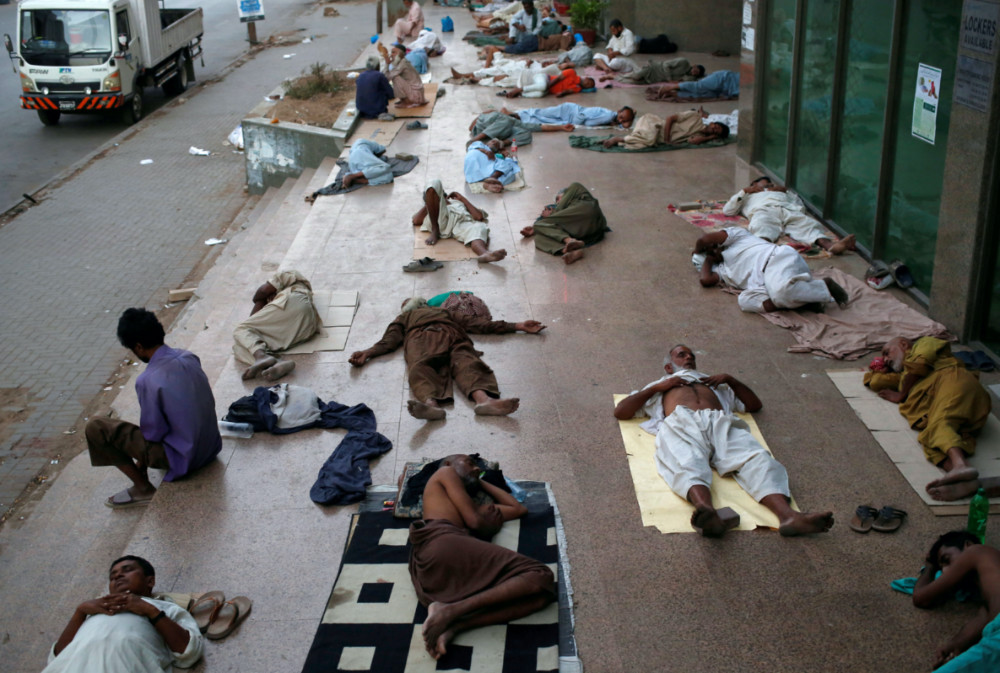London, UK
Thomson Reuters Foundation
Rising poverty, as the coronavirus pandemic slows economies, means an extra 50 million people this year may struggle without air conditioners, fans or other cooling devices needed to keep them healthy and productive, researchers warned Wednesday.
As governments see their budgets squeezed, some will lack cash to expand access to electricity, and even connected families may not be able to afford cooling, said researchers from Sustainable Energy for All (SEforALL), a UN-partnered organisation working on universal access to clean energy.

Residents sleep on a building pavement, to escape heat and frequent power outage in their residence area Karachi, Pakistan, on 22nd May, 2018. PICTURE: Reuters/Akhtar Soomro /File photo.
The widening cooling gap is expected to be worst in South Asia – where countries including India are now battling both more severe heatwaves and runaway COVID-19 infections – and, to a lesser extent, in sub-Saharan Africa, they said.
As climate change brings increasingly intense and risky heat extremes around the world, the decline in cooling access could have big impacts on health and productivity, said Brian Dean, head of energy efficiency and cooling for SEforALL.
“If somebody can’t sleep at night, they’re going to have mental and physical health issues, productivity issues the next day, learning issues if they’re in school,” he told an online briefing.
This is the first year the number of people at high risk from lack of cooling has gone up, he said, with the rural poor in particular likely to see a reversal from earlier gains.
The World Bank has estimated an additional 119 million to 124 million people were pushed into poverty in 2020 as a result of the coronavirus pandemic.
Altogether, more than a billion people around the world – largely in 54 most-vulnerable countries from Nigeria to Bangladesh – now fall into the high-risk category for lack of cooling, noted the latest SEforALL assessment.
The report, for the first time, also tried to identify states or districts where people are at high risk, even in countries with an overall lower risk.
In Mexico, for instance, both Veracruz and Guerrero states showed up as heavily threatened by heat and poor cooling access, as summer temperatures more often pass 35 to 40 degrees Celsius, said Alvin Jose, an energy specialist at SEforALL.
The report also identified particularly high-risk districts in the Indian states of Uttar Pradesh, Jharkhand and Bihar.
The aim of the finer-scale data is to help governments “triage” where to best spend limited money, Jose said.
A growing number of governments around the world have published national cooling plans, including China, India, Rwanda and Caribbean nations such as Cuba and Trinidad and Tobago, he noted.
India’s is particularly comprehensive, but even it must do more to put its plan into action, he added.
As Indian families wait outside hospitals in a desperate attempt to find oxygen for relatives sick with COVID-19, many are out in the sun in 40 degrees Celsius temperatures because hospitals do not have adequate shade, Jose said.
“There are a lot of issues in urban design (and) city planning” still to resolve, he said.
Low cost solutions
Ben Hartley, who works on energy efficiency and cooling access at SEforALL, said some low-cost ideas could help cash-strapped people and governments reduce heat risks.
White-painted “cool roofs”, for instance, have kept families in countries such as Bangladesh more comfortable in their homes even as temperatures soar outside, and planting trees similarly can cool urban spaces, he said.
In Indonesia’s industrial buildings, cool roofs have in some cases held indoor temperatures for workers 10 degrees lower than without them, he said.
“If you’re working in a highly dense environment with hundreds of other people, it can get very, very warm,” he said – which means such cooling efforts can be life-saving.
Jose noted that jobs in cooling have seen few layoffs even during pandemic lockdowns, in part as people working at home buy products and services to cope with hot conditions.
Sales of air conditioners and refrigerators also have remained strong as global temperatures rise and people prioritise staying cool, while effective refrigeration is essential for delivering coronavirus vaccines, he said.
Dean said he hoped low-cost cooling ideas could help ensure a coronavirus-linked rise in poverty would not also fuel heat-related risks, driving even more poverty.
“We’re pushing for solutions that will enable it not to be a downward spiral but an upward one,” he said.





